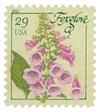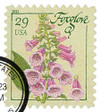
2011 29c Herbs: Foxglove
# 4507 - 2011 29c Herbs: Foxglove
$0.75 - $4.25
U.S. #4507
2011 29¢ Foxglove
Herbs
Issue Date: April 7, 2011
City: New York, NY
Printed By: Avery Dennison
Printing Method: Photogravure
Color: Multicolored
Tiny fairies live in the bell-like petals of the foxglove, or wear the flowers for their clothes. That’s just one example of the folklore surrounding this plant. Legends flourish about the foxglove, highlighting both the mystical appearance and the real-life contradictions about this plant.
One of foxglove’s oddities is the presence of both healing and harmful properties. When carefully extracted, it has proven useful in the treatment of heart disease, yet is also quite poisonous (and even deadly) to humans. Despite this, it can be found in some gardens. The flowers blossom in the second year, and are usually purple. Flowers are clustered around the stalk, which grows from three to six feet in height.
Foxglove’s name comes from the Anglo-Saxon phrase foxes glofa, or “gloves of the fox.” The flowers resemble the fingers of a glove, and one fable says mischievous fairies gave them to the fox to wear on his paws to help him sneak up on his prey.
This mythical background has led to nicknames such as “Goblin’s Gloves” and “Fairy Thimbles.” Foxglove’s poisonous features have led to other, darker nicknames, including “Dead Man’s Bells,” “Bloody Fingers,” and “Witches’ Glove.” Its colorful legends and pleasing appearance can make the foxglove an enchanting garden discovery.
U.S. #4507
2011 29¢ Foxglove
Herbs
Issue Date: April 7, 2011
City: New York, NY
Printed By: Avery Dennison
Printing Method: Photogravure
Color: Multicolored
Tiny fairies live in the bell-like petals of the foxglove, or wear the flowers for their clothes. That’s just one example of the folklore surrounding this plant. Legends flourish about the foxglove, highlighting both the mystical appearance and the real-life contradictions about this plant.
One of foxglove’s oddities is the presence of both healing and harmful properties. When carefully extracted, it has proven useful in the treatment of heart disease, yet is also quite poisonous (and even deadly) to humans. Despite this, it can be found in some gardens. The flowers blossom in the second year, and are usually purple. Flowers are clustered around the stalk, which grows from three to six feet in height.
Foxglove’s name comes from the Anglo-Saxon phrase foxes glofa, or “gloves of the fox.” The flowers resemble the fingers of a glove, and one fable says mischievous fairies gave them to the fox to wear on his paws to help him sneak up on his prey.
This mythical background has led to nicknames such as “Goblin’s Gloves” and “Fairy Thimbles.” Foxglove’s poisonous features have led to other, darker nicknames, including “Dead Man’s Bells,” “Bloody Fingers,” and “Witches’ Glove.” Its colorful legends and pleasing appearance can make the foxglove an enchanting garden discovery.










